Genomic mutations: definition and examples
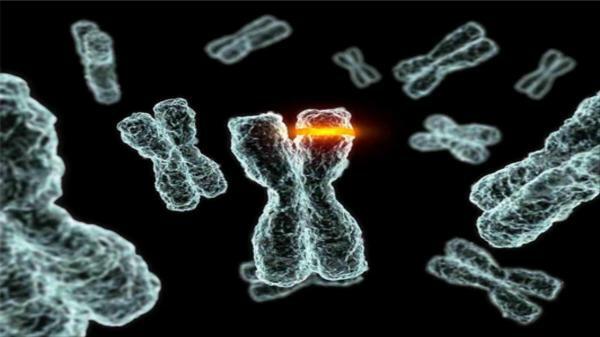
Image: Youtube
As we saw in a previous lesson from a TEACHER, the genetic mutations are all those stable variations that occur in the genetic material of an individual, that is, in their DNA. These genetic mutations can affect the sequence of one or more genes, but they can also affect the number of chromosomes. The latter of alterations are genomic mutations. Genomic mutations, in most cases, have great effects on people's lives and health. A well-known example of a syndrome caused by a genomic mutation is Down syndrome. In this lesson from a TEACHER we will delve a little more into the definition of genomic mutation and we will present examples of diseases caused by genomic mutations.
Index
- Definition of genomic mutation
- Types of genomic mutations
- Down syndrome: chromosome 21 trisomy
- Edwards syndrome: chromosome 18 trisomy
- Klinefelter syndrome: XXY sexual trisomy
- Turner syndrome: X chromosome monosomy
Definition of genomic mutation.
The genetic mutations
are defined as "stable variations of genetic material". As we saw in a previous lesson from a TEACHER, there are different types of genetic mutation since these modifications can affect a single nucleotide, one or more genes or even the number of chromosomes it has An individual. If you want to know more, you can take a look at our previous article Types of genetic mutation since in this lesson we will focus on studying genomic mutations only.Genomic mutations are those stable modifications of DNA that produce a change in the number of chromosomes. Remember that humans have two sets of 23 chromosomes, that is, we have two chromosomes, one (one inherited from our father and another from our mother), two chromosomes two, two chromosomes three and so on successively. Most of our cells are diploid (except gametes, ovules, and sperm). The last set of chromosomes, number 23, is called the sex chromosome pair, and we also have two copies: the same in women (XX) and different in men (XY).
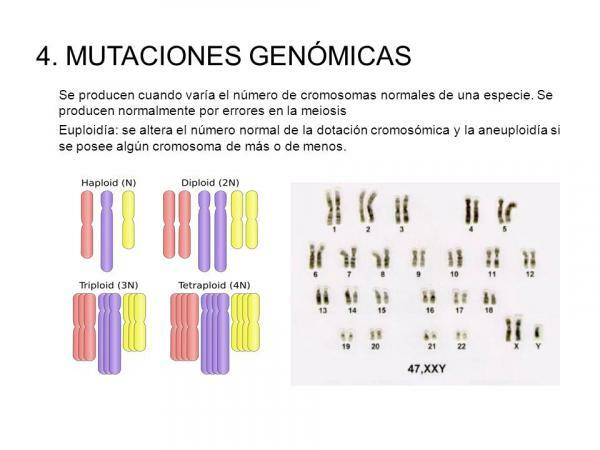
Image: SlidePlayer
Types of genomic mutations.
As with the modifications of the genetic sequence, which can affect a small part (genetic mutation) or a larger fragment (chromosomal mutations), genomic mutations can also have different levels of involvement. There are two different types of modifications that can affect the number of chromosomes:
- Euploidy: In this case, a variation of complete sets of chromosomes occurs. For example, in the case of humans, a set of chromosomes may disappear and a cell may have only 23 chromosomes, one of each number (haploid). This occurs naturally in the gametes (egg and sperm). It may also be that a cell has three or more sets of chromosomes: three (triploid), four (tetraploid), etc. copies of each chromosome. This does not occur in humans naturally but in some species of animals or plants. In humans, if euploid organisms are produced during fertilization, development cannot be completed and abortion occurs.
- Aneuploidy: In this case there is a variation of the chromosome set only in one of the chromosomes. The best known example, and that we will see next is Down Syndrome. Those affected by Down Syndrome have three copies of chromosome 21 while it is normal to have only two copies of this chromosome. The alteration of the number of sets of chromosomes can greatly affect the development of the organism and the Most prevent the body from ending gestation within the mother and causing abortions. In other cases, such as the ones we will see below, individuals are born.
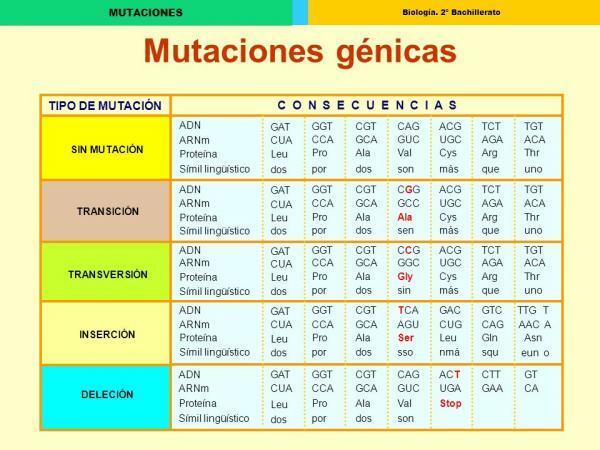
Image: Typesdecosas.com
Down syndrome: chromosome 21 trisomy.
The Down's Syndrome It is an aneuploidy since it is an affectation caused by the appearance of three copies of chromosomes 21, instead of the usual two copies (trisomy of chromosome 21). This affectation is called syndrome because the alteration generates a set of diseases that can be: heart disease, different degrees of mental retardation, difficulties in speaking, etc. or more likely than the rest of the population to suffer from diseases such as Alzheimer's, celiac disease or vision and hearing problems. Despite all this, people with Down syndrome can live for many years and have a quality of more or less good life that allows them to work, study, play sports or even be stars of movie theater!
The frequency of appearance of children with Down syndrome is than 1 in 800 births. Although any woman can give birth to children with this syndrome, the chances have been shown to increase with the age of the mother. Also, like most syndromes caused by genomic mutations, Down syndrome is not inherited since the mutation occurs during the production of one of the gametes, usually of a specific ovum and in a isolated.

Edwards syndrome: chromosome 18 trisomy.
The Edwards syndromeLike the previous case, it is an aneuploidy but in this case it affects chromosome 18. Individuals with this syndrome have three copies of chromosome 18. These individuals tend to have a low weight and height at birth, since their development within the uterus is slower than normal. In addition, they often have heart conditions or head malformations (change in the shape of the head or jaw).
Due to the severity of the disorders and their fragility at birth, unfortunately many of the children with Edwards syndrome die within a few months of birth.
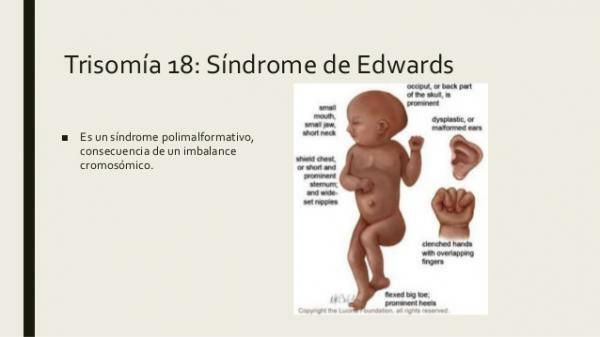
Image: SlideShare
Klinefelter syndrome: XXY sexual trisomy.
Aneuploidies not only affect somatic chromosomes, but can also affect sex cells. This is the case of Klinefelter syndrome, a trisomy that appears in men who have two X crosomosomes and one Y chromosome. Let us remember that individuals with the genotype 47, XXY are men since they have a Y chromosome which, in the human species, is what makes an individual male.
The alterations caused by this genomic mutation are not as drastic as the previous ones. Men with Klinefelter syndrome may be taller than normal, infertile, or slightly retarded. although, on many occasions, these alterations are so weak that 75% of men are never diagnosed. These individuals live normal lives although they may be more likely to develop diseases such as metabolic syndrome or breast cancer.
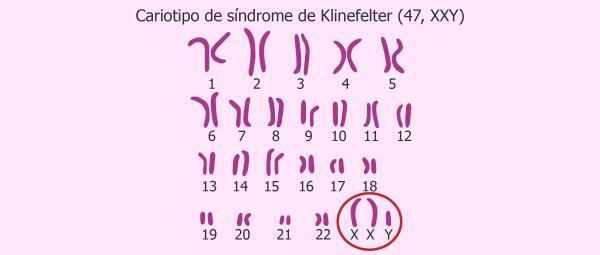
Image: Egg donor
Turner syndrome: X chromosome monosomy.
As in the previous case, Turner Syndrome is an aneuploidy that It affects the sex chromosomes, in this case the X chromosome. Turner syndrome consists of the monosomy of the X chromosome, that is, only one sex chromosome, X, appears instead of two as is normal. Individuals with Turner Syndrome are women (since they do not have a Y chromosome) who are often short and, like Klinefelter Syndrome, lead to infertility. Women with this disease do not reach puberty naturally and are helped by hormonal treatments.
As in the previous case, women with Turner Syndrome can live for many years, although most are diagnosed. In some cases, this syndrome may carry an increased risk of heart or kidney disease.
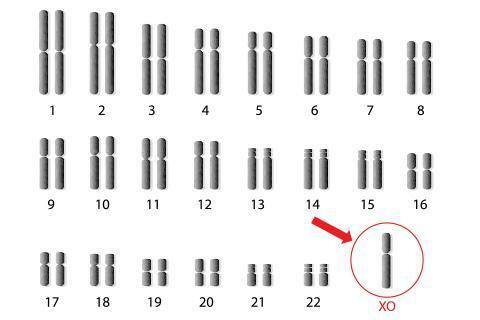
Image: Webconsultas
If you want to read more articles similar to Genomic mutations: definition and examples, we recommend that you enter our category of biology.
Bibliography
- Genetics Home Reference (June 2012). Down Syndrome. Recovered from https://ghr.nlm.nih.gov/condition/down-syndrome#
- Genetics Home Reference (March 2012). Trisomy 18. Recovered from https://ghr.nlm.nih.gov/condition/trisomy-18
- Genetics Home Reference (April 2019). Klinefelter Syndrome. Recovered from https://ghr.nlm.nih.gov/condition/klinefelter-syndrome#
- Genetics Home Reference (October 2017). Turner Syndrome. Recovered from https://ghr.nlm.nih.gov/condition/turner-syndrome



